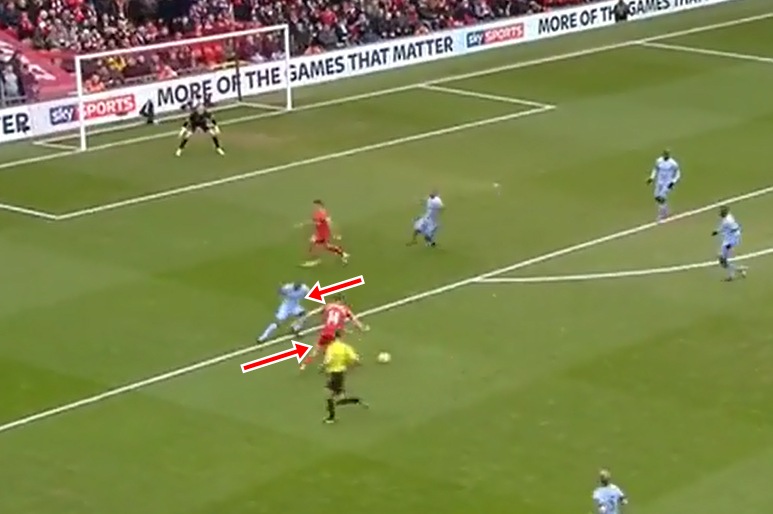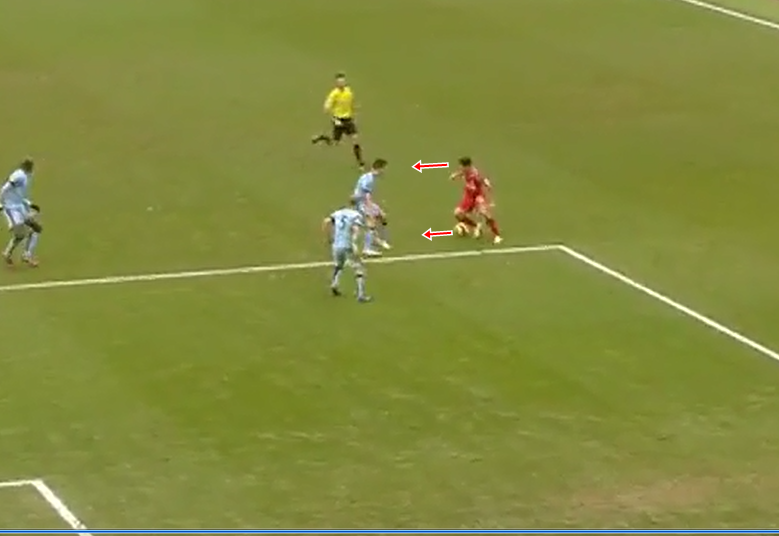A few years ago, the stat you see above came out, showing that Michael Carrick played more forward passes than any other midfielder in Europe. This was met with nodding approval by a small (and smug) minority, but with howls of disbelief elsewhere, even among some Manchester United fans. "But he plays so many sideways and backwards passes!" went the common objection. This ignored two important points:
1) The claim wasn't that Carrick played a majority of his passes forward, or that he played a lot of them, in general; just that he played more of them than anybody else. He did, in fact, play a lot of passes sideways and backwards, but so do most players, and for good reason: those are the best options that are available to them most often.
2) Confirmation bias prevented many people from "seeing" the pattern of Carrick's forward passes, even if they did see each individual forward pass. A fan who had already decided Carrick "never" plays the ball forward will greet each one as if it is an anomaly, perhaps with a sarcastic cheer or a bitter "Finally!" Confirmation bias - the tendency to interpret any new information in a way that supports your pre-existing opinions - is rife among supporters, because supporters are passionate and biased, and watch matches in a state of heightened anxiety and emotion. Supporters also tend to make absolute statements about players - Valencia "never" uses his left foot, Defoe is "always" offside, etc - statements they don't take seriously themselves on the surface, but which can still affect their perceptions.
Hint: He's Good
Not every aspect of this free-flowing game can be accurately measured and judged according to statistics. But many hard numbers can be quantified - number of crosses, number of tackles, aerial duels won, etc. I would argue it's impossible for any one supporter, especially when watching his or her own team, to accurately sum up every player's contributions to a game. In fact, we are often way off in our assessment. I'll use myself as an example.
When I was coaching at NC State, we used a service called ProZone. You may have heard of it. ProZone uses a set of cameras placed around the stadium, and extremely meticulous and tedious work by its analysts, to track and graph every action throughout a match, and represent each pass, shot, tackle, cross, run, etc as a computer graphic (with a link to a video clip of each action). There are a number of similar services, and they are growing in popularity among coaches.
ProZone confirmed something I had suspected of myself: despite over 20 years in coaching, I am just as vulnerable to confirmation bias as anyone else. Here's how it might work: during a match, as I watched on in a typical state of anxiety (if you don't know anything about the U.S. university level, just know that coaches get fired for bad results, just like at the professional levels), our midfield #7 might mis-play a pass, then do it again a few minutes later. And under my breath, I might mutter, "Having a nightmare."
But then the ProZone analysis would arrive the next day, and I would see #7 with a 92.2% pass completion rate. Okay, but maybe that was because of all the easy ones, the sideways and backwards ones. ProZone lets you apply a wide array of filters to the results, so let's look at only forward passes: 77% successful. Hmm. That's a very good percentage for forward passes.
ProZone screen shot, showing successful passes in blue, unsuccessful in red
The reason I might feel so frustrated by the player in real time is obvious: I want to win, so I want every pass to be perfect, and it's easy to over-dramatize "failure" in this context. Also, some "failures" are going to loom larger in the mind of a coach/supporter than others. For example, when a clear chance to counter is on, but the midfielder plays a bad ball, you're going to notice and remember that one much easier than the previous five nifty little balls played right into feet. That's because such a ball stabs you directly in the heart. "We had them," you cry, and then you probably tweet about it.
Confirmation bias plays an important role, too. In a game where I expect our left back to have problems with a speedy winger, I'm going to nod sagely to myself any time the winger gets in a cross. "We're getting killed down the left," I might think. But ProZone might show that the left back won 12 of 16 tackles, and the winger got in only two crosses. My expectations unfairly conflated the outcome.
But hang on - what if those two crosses both resulted in goals, and we lost 2-1? Well, then we really did get killed down the left. But such an outcome indicates problems beyond the left back, such as the high percentage of crosses that get turned into goals.
Human comprehension and memory also don't work nearly as well as we think they do (as court witnesses regularly prove). A supporter at a match might watch his side concede a goal, fume that Jenkins didn't pick up his man, then see the highlights later that night, only to realize it wasn't Jenkins' man at all. In the last professional game I played, I recall conceding from a header, looking at the defender who was out-jumped, and magnanimously deciding not to shout at him. Good thing, because when I watched the video later, it wasn't him who was out-jumped.
Once I analyzed a few matches with ProZone (in full disclosure, this was the main responsibility of others on our coaching staff, but I was often present, and we talked about it a lot), I tried to temper my responses in real time. I saw a stray pass or poor cross for what it was: a statistical necessity, and also possibly an outlier, rather than a microcosm of the player's overall performance.
One of the things ProZone, and stats in general, does an excellent job of is illustrating trends. If your side struggles to get balls into the box, or passes into the feet of strikers, or change the point of attack in midfield, you're going to see it right there on the screen, in glowing red lines and numbers. What no stat or app can accurately do is put these moments into context. A midfielder who only rarely switches the play might be a victim of teammates not moving into proper space, or might simply be on the end of too many hospital balls, and not have enough time to see the entire pitch. A coach or supporter is still going to judge players and performances largely based on what they see in real time, and this at least has the potential to give you a fairly accurate overall assessment. But there are simply too many players, involved in too many actions, to be able to judge for certain. Tools like ProZone help fill in the gaps, and take away the bias, from what we see.
















